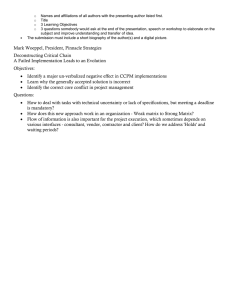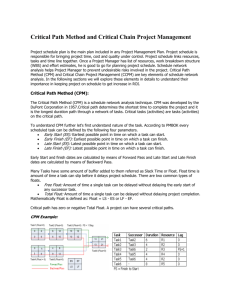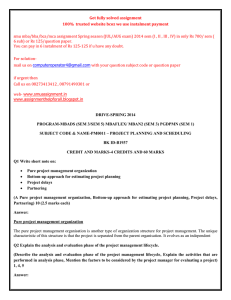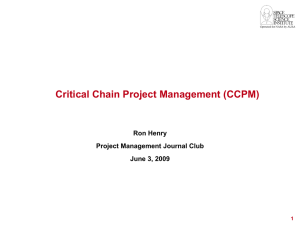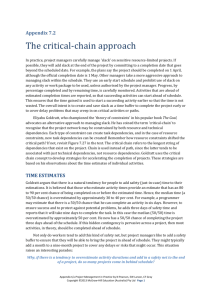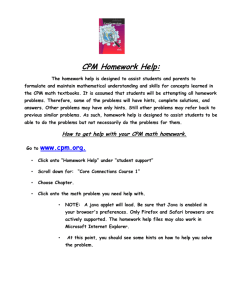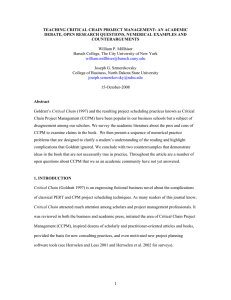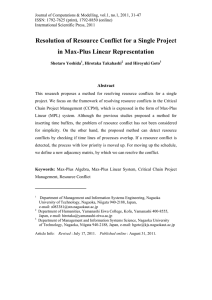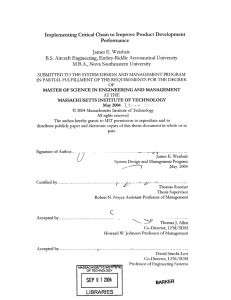Theory of Constraints: A look at the Drum-Buffer
advertisement
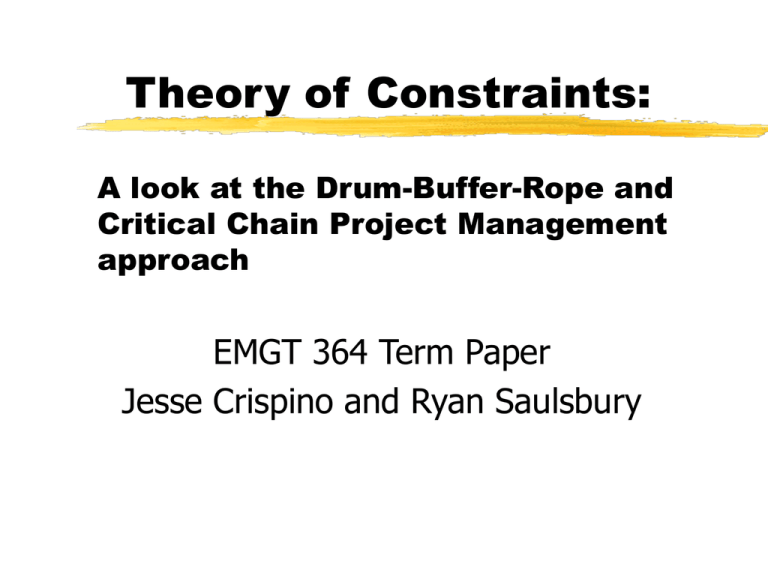
Theory of Constraints: A look at the Drum-Buffer-Rope and Critical Chain Project Management approach EMGT 364 Term Paper Jesse Crispino and Ryan Saulsbury Theory of Constraints Developed by Eliyahu M. Goldratt A systems management philosophy developed in the 1980s Boost process performance by looking at the entire process Identifying and reducing “bottlenecks” Often applied in conjunction with TQM, JIT and ABM Theory of Constraints Project managers have always analyzed individual components of a process Maximizing components may not improve the process Goldratt views the entire process and finds the weakest link--Capacity Constrained Resource (CCR) All projects contain one, but not many CCRs Theory of Constraints: Principles If a system is performing as well as it can, only one of its component parts will be. If all parts are performing as well as they can, the system as a whole will not be. Inertial is the worst enemy of a process of ongoing improvement. Solutions develop weight that resists change. Ideas are not solution. Theory of Constraints: Steps Goldratt’s Five Steps Identify the systems constraints Decide how to exploit the constraints Subordinate everything else to the exploitation of constraints Elevate the systems constraint If any constraints have been violated, repeat the process Theory of Constraints: Defined Constraint: Anything that limits a system’s performance relative to its goal Inventory: All the money used to purchase things the system intends to sell Operating expense: The money a system spends to turn inventory into throughput Throughput accounting: An accounting system used to measure TOC operations Theory of Constraints: Defined Throughput: the difference between net revenues and direct material cost limited by internal constraints (plant capacity) limited by external constraints (market demand) Two critical assumptions: The goal of product or customer mix and volume should be to maximize throughput Assumes that once a certain capacity exists, operating expenses are fixed Theory of Constraints: Applied Soldier analogy: Gaps appear due to Dependent events Statistical fluctuation Drum-Buffer-Rope (DBR) system links first “soldier” with the slowest one Drum-Buffer-Rope (DBR) Logistical tool that balances flow of a system Drum: A schedule for capacity of the constraint Buffer: Built in time for parts to reach the constraint early (in process inventory) Rope: A schedule, or information connection, for releasing raw materials Drum-Buffer-Rope: Implementing Identify CCRs-Pareto’s Rule may help Schedule CCRs to capacity (drum) Protect from statistical fluctuations with time buffers (buffer) Monitor CCRs to ensure the timely release of materials “upstream” (rope) Monitor Buffer--Buffer Management (BM) Drum-Buffer-Rope: Case Study #1 Oregon Freeze Dry: Four step process wash/prepare food freeze food in cold room dry food to remove ice crystals (sublimation) packaging/shipping Difficulty finding space in cold room-wash/preparation was very quick Considered buying new cold room Drum-Buffer-Rope: Case Study #1 Reduced the amount of raw food going into wash phase Cold room scheduled by using a BTU calculation for max efficiency Less product in cold room created faster freezing rates. Oregon Freeze uses only 30% of cold room capacity and produces a higher quality product Drum-Buffer-Rope: Case Study #2 Wendell August Forge: Hand-hammered aluminum commemorative items Six production cells Expected hammering to be drum Walk on shop floor showed buffing backup to be CCR Union mandated breaks Drum-Buffer-Rope: Case Study #2 Break schedule staggered--exploitation Capacity immediately increased 12% Implemented a Rope to limit raw materials Work in progress inventories decreased Managers educated on TOC attitudes Capacity up 27% by years Critical Chain Project Management Traditional project management, Critical Path Method (CPM) used for over 40 years DoD projects: 100-200% more expensive, and exceeded duration 40-50% of the time Commercial projects: 70% more expensive, and exceeded duration 40% of the time Goldratt’s 1997 book Critical Chain--new paradigm for PMs People plan and execute projects Critical Chain Project Management Accounts for human nature factors Individuals always desire a safety buffer Goldratt’s “student syndrome” Parkinson’s law--Work expands to fill the time allotted PM multi-tasking reduces efficiency and penalizes the highest priority No early finishes Critical Chain Project Management CPM: Tasks scheduled as soon as possible (ASAP) CCPM: Tasks scheduled as late as possible (ASLP) Reduce work in progress Reduce up-front costs PMs focus on first tasks Increased knowledge as project progresses Critical Chain Project Management ALAP drawback: As the project progresses, all tasks become critical to project completion Goldratt’s solution: Drum-Buffer-Rope logistical scheduling and consolidated safety buffers CCPM: Re-define Your Paradigm CCPM requires individual and organizational behavior changes Locate and remove hidden safety buffers Embrace uncertainty vs attempting better estimates A 50% change of completing a task on-time is acceptable--Do not measure against baseline “Tell me how you will measure me and I will tell you how I will behave” CCPM: Implementing Assume all material and information for tasks are on-hand Resolve resource conflicts Locate the Critical Chain--longest chain of tasks that consider both task and resource dependencies Critical Path--longest chain of tasks based upon task dependencies CCPM: Implementing Individual projects no longer have safety buffer Two types of safety buffers are inserted into the project as a whole Project Buffer: protects against overruns on the critical chain Feeding Buffer: protects against overruns on tasks that feed the critical chain CPM vs CCPM CPM: Tasks have scheduled start and finish dates Early finishes on critical path do not accumulate Project is on time or late CCPM: Relay race analogy Tasks are scheduled by preceding tasks completion CPM vs CCPM CCPM will finish tasks faster Project team’s moral and effectiveness will improve Project teams/project managers can produce early finishes Overall costs will decline CPM Start Finish - Indicates critical path CCPM Rope Resource Buffer Start Feeding Buffer - Indicates critical chain Project Buffer Finish Critical Chain: Case Study #1 Harris Semi-conductor: $250M new wafer fabrication plant Typical construction time 54 months CPM analysis yielded 6000 tasks Critical chain analysis reduced to 150 tasks 40 day delay for weather 15 day delay for equipment problems Critical Chain: Case Study #1 Buffers allowed for project delays Project completed 3 days ahead of schedule Plant constructed in 13 months Overall cost only 4% above estimate Wafer Fabrication plant able to produce products 40 months faster than the industry standard Critical Chain: Case Study #2 Habitat for Humanity: World Record attempt for building a house Old record: 4hrs 39min, Nashville--1998 Critical Chain method predicted 4 hours Bathroom finished 1 hour longer than estimated Overall finishing time: 3hrs 44min In Class Example: You are a new plant manager for LETZ GETZ BLITZED BREWING CO INC. You need to re-work the production line soon because your boss, CEO Always Hammered is getting thirsty for the profits so to speak. Your Suppliers Bottle Cap Billy, and Hops McGee are consistently late. Your line supervisor Mr. Schmidt explains that those producers are from Denmark and the delays are due to rotten shipping. In Class Example: Current Situation: The Hops & Malt used in the brewing process is suppose to arrive on the 1st of each month but it can arrive 1 day late. Yeast is purchased in bulk and is delivered on the 4th of the month. The line supervisor claims yeast requires 4 days of preparation before being added to the WORT. Packaging is delivered on the 11th of the month and requires imprinting and then fix/assembly (2days total) Your bottles are delivered on the 15th. You can fix the labels and assemble the packaging after your bottles arrive. Bottle caps are suppose to arrive on the 16th but lately they have been a day late. You are unable to obtain new suppliers because of existing contracts signed by the CEO. In Class Example: The following is a general concept of how to make the beer in your factory: Step 1: You can start by creating the WORT. A process that includes adding water, hops, malt and then a boiling/cooling process. ( 1 day) Step 2: Transfer to the fermenter where the yeast is added Step 3: Fermentation (10 days-Cannot be reduced) Step 4: Final Preparation includes: Siphon beer to remove yeast sediment, Add Sugar-Bitters added to product to produce, and carbonation (4 days) Step 5: Bottling/Packaging (2 days) In Class Example CPM: In Class Example CCPM: Develop a CCPM for the Beer Making Process Remember: Reduce the Critical Path by 50%, Project Buffer(5 days) Feeder Buffer(2 total) Critical Chain vs Critical Path for Army/UMR? Must teach both techniques CCPM CPM Army constrained by resources Operations difficult to apply Maintenance has potential Key differences ASAP vs. ASLP Buffer Management Drum-Buffer-Rope & Critical Chain Method QUESTIONS ??
